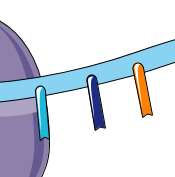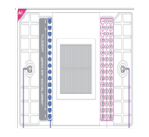Digital PCR
The platform is equipped for digital PCR with Biomark-HDTM systems from Fluidigm and NaicaTM from Stilla Technologies
Digital PCR allows the direct quantification of a genome element (DNA or RNA) in a biological or environmental sample. The general principle consists of discretising the sample (dividing it equally) into a large number of independent reaction chambers which will contain either 1 or 0 copies of the element to be quantified. Each chamber (or partition) behaves like an independent PCR reactor, where the fluorescent chemistries used in qPCR (hydrolysis or hybridization probes, DNA intercalators) associated with the selected primers, will allow the specific amplification of the targeted elements. At the end of the PCR the positive and negative partitions are counted and related to the total number of partitions. The statistical distribution of the target molecule in the partitions follows a Poisson distribution (rare event statistic) and allows an accurate estimation of the initial amount of DNA or RNA in a test sample. This approach thus allows an absolute quantification of the target molecules in the sample and is particularly suitable for the detection of rare events.
The sensitivity of detection depends mainly on the total number of individual compartments, and thus target sequences that can be analysed. The higher the number of compartments, the higher the sensitivity. The new microfluidic digital PCR technologies make it possible to obtain a large number of compartments in the form of microchambers or nanodroplets. The platform is therefore equipped with two technologies:
-
- Digital PCR in microchambers (dPCR) with the Biomark-HDTM system from Fluidigm
-
- High resolution digital PCR in nanodroplets (cdPCR) with the NaicaTM system from Stilla Technologies

dPCR
Fluidigm’s Digital Array chips allow the sample to be distributed (or discretised) into 765 or 770 reaction chambers on a microfluidic chip. Each chip consists of small volume reaction chambers (6nL or 0.85nL) and an integrated fluidic circuit (IFC). This set of interconnected microchannels allows the circulation of fluids (samples, mix and primers) and their distribution in the reaction chambers. The circulation of fluids is ensured by an IFC controller, which, by means of pressure differences, causes the opening or closing of NanoFlexTM valves for the distribution and mixing of samples and primers. Amplification and fluorescence readout (2 detection channels) are provided by the Biomark-HD™ system itself. After several PCR cycles, the concentration of a target DNA or RNA is determined from the ratio of the number of positive chambers (where at least one copy of the DNA or RNA sequence under investigation has been amplified) to the total number of reaction chambers. By applying Poisson’s law to this ratio, the initial copy number of the target of interest in the sample can be accurately estimated.
cdPCR
Stilla Technologies’ Naica™ system offers a highly sensitive nucleic acid detection and quantification technique called Crystal Digital™ PCR (cdPCR). This microfluidic technique is based on the use of aqueous droplets dispersed in oil to compartmentalise a large number of independent PCR reactions. Tens of thousands of nanodroplets (20,000 to 30,000 depending on chip size) are assembled in a drop crystal within a chip. The identically sized droplets are stabilised by surfactants to prevent coalescence. Thus, target molecules (DNA, RNA, miRNA, mutants), identified by different fluorochromes, can be independently amplified in the droplets at a maximum of 1 molecule per compartment. A light signal is measured within each droplet to detect the presence or absence of the molecule of interest and thus directly determine the copy number of the target molecule in a biological sample. Each chip incorporates 4 or 16 droplet crystals (depending on chip size) for analysis of 4 or 16 samples/chip. Analysis capacity per PCR run: 3 chips or 12 to 48 samples per run.
Depending on the dPCR or cdPCR technology chosen, 4 chip formats are available:
dPCR microfluidic
12.765 chips
- 12 samples in 765 rooms
- 6nL chamber
- 9,180 PCR reactions
dPCR 37k chips
- 48 samples in 770 chambers
- 0.85nL chamber
- 36,720 PCR reactions
cdPCR in nanodroplets
Sapphire chip
- Up to 12 samples/run
- 30,000 droplets generated/sample
Opale chip
- Up to 48 samples/run
- 20,000 droplets generated/sample
- Absolute quantification of nucleic acids (DNA, RNA).
- Personalised medicine in oncology (patient follow-up based on simple blood tests).
- Monitoring of gene and/or cell therapies.
- Genotyping of animal or cell lines.
- Analysis of chromosomal abnormalities (CNV) and the presence of polymorphisms (SNP).
- Monitoring of pathogens in wastewater, identification of viral genetic variants.
- Detection of rare events.
- Identification of biomarkers present in small quantities in biological fluids (blood, urine, saliva) or in the environment.
- Multiplexing capability allowing the simultaneous characterisation of several genetic elements in the same sample (3 to 6 detection channels), allowing the optimal use of valuable and/or rare samples.
- Encapsulation and amplification on nuclei or single cells
Advantages of the digital PCR approach
- Accuracy and direct quantification (n copies/µL).
- Increased sensitivity: ability to detect rare events in a sample (0.01%) or biomarkers in very low quantities (0.25 copies/μL).
- Multiple fluorescence detection channels: 2 to 6 wavelengths (blue, cyan, green, yellow, red, infrared).
- Digital PCR may require dilution of samples to avoid saturating compartmentalization capabilities.
- Digital PCR emulsion technologies, which generate nanodroplets, must be compatible with PCR mix chemistries to avoid coalescence phenomena.





















